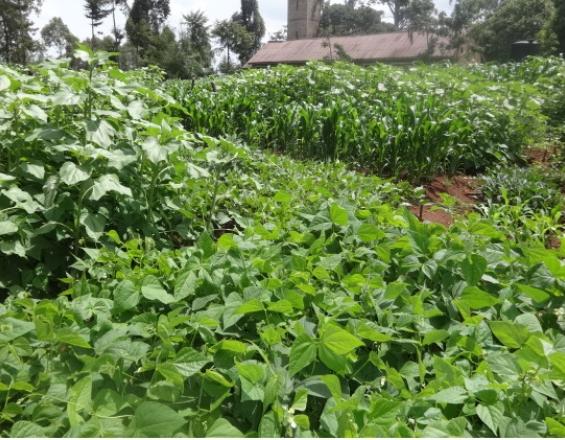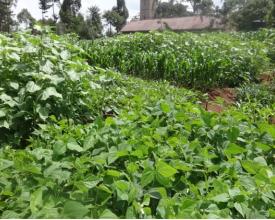
Using biointensive agriculture to improve nutrition, income and food security

Over 70% farmers in Kenya are Small-scale farmers practicing conventional farming and use fertilizers. This is unsustainable and produces most greenhouse gases causing high temperatures and low soil P.H. which have adversely reduced yields of maize and beans thus threatening food security in Trans-Nzoia County. Due to recent drought, farmers are cultivating riparian land for food resulting in silting and rivers pollution. Biointensive Agriculture is the solution. It produces 2-4 times more food, improves nutrition, promotes biodiversity and protects the environment.
Manor House Agricultural Centre creates awareness on the dangers of conventional agriculture through training, research and extension on Biointensive agriculture (BIA). BIA is a low cost way of farming which uses locally available resources. This has improved biodiversity and sustainability of food production by smallholders with fewer resources while conserving the environment.
Context
Challenges addressed
Environmental
Over 70% of farmers in Kenya are Small-scale farmers practicing conventional farming and use fertilizers. This is unsustainable and produces most greenhouse gases causing high temperatures and low soil P.H. which have adversely reduced yields thus threatening food security. Due to recent drought, farmers are cultivating riparian land for food resulting in silting and rivers pollution.
Economic
Use of conventional farming methods by small scale farmers is uneconomical and often results in poor yields, emission of greenhouse gases causing climate change and it is basically unsustainable and unsuitable to small scale farmers, wh are often lacking resources.
Social
BIA is labour intensive, so it has helped in reducing idleness of members of the community and occupied youths in manual work thus giving no time for getting involved in petty crimes due to idleness.
Location
Process
Summary of the process
This project aims at training of Trainers on BIA. It involves introductory lessons on Biointensive agriculture and other sustainable ideas carried out indoors. After this familiarization with the concepts, the trainees are subjected to demonstrations to aid in acquiring of relevant practical skills and finally participatory action based on-farm training. Discussions and sharing of ideas and experiences is highly encouraged at this stage and upholding is equally emphasized. Thematic approach based on soil conversation, long term soil fertility building, ecological farm management practices and energy saving are stressed.
The farmers are then followed up to assist in adoption of the ideas and their implementation.
These include continuous and regular visits by the field based staff in order to guide, advice direct and motivate them. Planning for real at this stage emerge given that the community members come up with various strategic livelihood improvement projects.
Building Blocks
Training of farmers
The method used in training involves introductory lessons on Biointensive agriculture and other sustainable ideas carried out indoors. After this familiarization with the concepts, the farmers are subjected to demonstrations to aid in acquiring of relevant practical skills and finally participatory action based on-farm training. Discussions and sharing of ideas and experiences is highly encouraged at this stage and upholding is equally emphasized. Thematic approach based on soil conversation, long term soil fertility building, ecological farm management practices and energy saving are stressed. Initially, trainers of trainees are selected from famer groups. They are then trained at Manor House Agricultural Centre. They are then sent to establish mini-training centre in the community where they train other farmers
Enabling factors
The community members will have an interest in sustainable methods of farming – Biointensive agriculture i.e. avail themselves for the trainings, and play their duly part during training and implementation of the project in order to make a lasting impact.
The social-economic political and weather conditions will allow for the process of awareness, training and more importantly adoption and implementation of the ideas.
Lesson learned
After this familiarization with the concepts of BIA, the farmers are able to adopt the technology. this is as a result of observation made from the demostrations during training and discussions, sharing of ideas and experiences
Follow Ups and Extension
The extension staff usually discuss farmer priorities with them and then develop appropriate farming interventions. Trained farmers are offered post training services geared towards smooth transition to sustainable practices. These include continuous and regular visits by the field based staff in order to guide, advice direct and motivate them. Planning for real at this stage emerge given that the community members come up with various strategic livelihood improvement projects.
Enabling factors
The group members will have an interest in sustainable methods of farming – Biointensive agriculture
The social-economic political and weather conditions will allow for the process of follow ups, training and more importantly adoption and implementation of the ideas.
Lesson learned
Sensitized and trained community members might be able to hold together onto their convenient groupings making it easy for follow ups and sharing of ideas.
Farmers are aware of risks of synthetic products and or transgenic seeds.
The group members have come up with various strategic livelihood improvement projects.
Impacts
The methods described under the 8 key components of BIA solution are employed and farmers are adopting this. The positive impact of adopting this model is seen in regard to soil regeneration, food, nutrition, health, income. The whole gardening system suits the farmers well.
Other long lasting effects are better living standards and reduced poverty levels among the community members. Adversities in climatic change such as desertification and effects of global warming will be mitigated.
Beneficiaries
The target beneficiaries are the small scale holders who are affected most by the prohibitive cost of agricultural production and the escalating land degradation through contamination by toxic inputs and loss of fertility through erosion.
